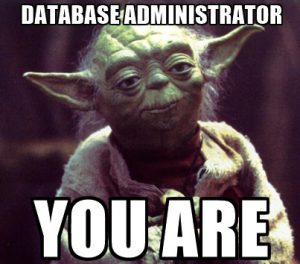Thilo, mein alter Azubi Kollege , und ich haben dieses Jahr das erste mal am AnsibleFest in London teilgenommen. Ziel davon war es, den Blickwinkel zu erweitern und zu sehen, welche Möglichkeiten es mit Ansible gibt und wie sie von anderen Unternehmen ausgeschöpft werden.
, und ich haben dieses Jahr das erste mal am AnsibleFest in London teilgenommen. Ziel davon war es, den Blickwinkel zu erweitern und zu sehen, welche Möglichkeiten es mit Ansible gibt und wie sie von anderen Unternehmen ausgeschöpft werden.
Die Unternehmen, die Vorträge gehalte oder an Interviews teilgenommen haben, erstrecken sich von Siemens, über Ansible selbst bis hin zur britischen Armee. Mich hat sehr erstaunt, dass sogar die britische Armee Ansible im produktiven Einsatz hat und dann auch einen Talk darüber abhält!
Das Ambiente war sehr vornehm. Die Veranstaltung fand im „InterContinental London“ statt. Wie wir es von NETWAYS Veranstaltungen schon gewohnt sind, gab es reichlich zu Essen und zu Trinken, was uns nach der etwas längeren Anreise, doch zu Gute kam.
Als OpenSource Firma kommen wir bei NETWAYS immer mehr in Kontakt mit dem Configuration Management Tool Ansible. Bereits die ersten Kunden sind auf uns, eben wegen Ansible zugekommen und haben in Zusammenarbeit mit uns ihr Setup aufgebaut. Die Verwaltung der Produktivsysteme läuft demnach mit Ansible und diese Konfigurationen sind sowohl für uns als Administratoren als auch für den Kunden selbst mittels Git zugänglich. Falls auch ihr euch überlegt, eure Systeme mit Ansible zu verwalten, dann kommt gerne auf uns zu! Wir helfen gerne.
Zum Abschluss sind hier noch Bilder vom Hotel sowie von der Anreise hinterlegt.
NETWAYS Blog
PHP Error – php_network_getaddresses
Ein Problem zu dem es viele Lösungsansätze gibt, ist folgender PHP Fehler. Er tritt beispielsweise auf, beim Verbinden auf externe Anwendungen oder APIs:
php_network_getaddresses: getaddrinfo failed: No address associated with hostname
Im Netz kursieren Teilweise die wildesten Lösungsansätze. Da ich vor kurzem mit eben diesem Problem konfrontiert wurde, möchte ich meine Erfahrung mit euch teilen. In der „php.ini“ gibt es einen Parameter, der diesen Fehler verursachen kann.
Dieser kann unterschiedlich gefüllt sein und ist per default leer.
disable_functions = pcntl_alarm,pcntl_fork,,pcntl_wait,pcntl_wifexited,pcntl_wifstopped,pcntl_wifsignaled,pcntl_wexitstatus,pcntl_wtermsig,,pcntl_signal,,pcntl_get_last_error,pcntl_strerror,pcntl_sigprocmask,pcntl_sigwaitinfo,,pcntl_exec,pcntl_getpriority,pcntl_setpriority
Um obigen Fehler zu beheben, kann es also reichen, sich diesen Parameter anzusehen und notfalls sogar komplett zu leeren.
Ubuntu Unity vermutlich bald tot
 Wie diverse Medien berichteten, wird „Unity 8“ nicht mehr weiter entwickelt. Es wurde unter Ubuntu 16.10 zwar eingeführt, jedoch nur als Vorabversion. Ebenso wurde die Entwicklung am Ubuntu Phone eingestellt. Als Grund gab Canonical an, dass es wohl viel Arbeitsaufwand gekostet hat, wenig Fortschritt zu verzeichnen war und beides in der Community wenig Anklang gefunden hat.
Wie diverse Medien berichteten, wird „Unity 8“ nicht mehr weiter entwickelt. Es wurde unter Ubuntu 16.10 zwar eingeführt, jedoch nur als Vorabversion. Ebenso wurde die Entwicklung am Ubuntu Phone eingestellt. Als Grund gab Canonical an, dass es wohl viel Arbeitsaufwand gekostet hat, wenig Fortschritt zu verzeichnen war und beides in der Community wenig Anklang gefunden hat.
Das hauseigene „Unity 7“ wird zudem ebenfalls bald nicht mehr im Einsatz sein. Ab Ubuntu 18.04 LTS wird Ubuntu wieder mit Gnome 3 ausgeliefert werden. Die Entscheidung sei nicht leicht gefallen, so Canonical-Gründer Mark Shuttleworth, jedoch möchte Canonical das Augenmerk vermehrt auf das IoT (Internet of Things) und die „Cloud“ legen.
Obwohl Unity von Anfang an bei den Usern stark umstritten war, werden doch viele User die leicht zu bedienende Oberfläche nun vermissen. Ich selbst hatte meinen Einstieg mit Ubuntu in Kombination mit dem „Unity 7“ und habe damit gut in die große weite Welt der Linux-Systeme gefunden.
RIP Ubuntu 12.04 LTS
An era is coming to an end. Ubuntu 12.04 LTS was released in the spring of 2012. At the 28th of April 2017 the support for this Ubuntu Version will comming to a close.
Each user now has the task to upgrade to a newer version of Ubuntu.
As a hoster with the mission to take care of the systems of our customers, we have a scarily high number of servers we have to take care of. Even if we are up to this task, we still need the cooperation of our customers, as we have to prevent possible failures. And a few of our customers, don’t see the the problems, that we are up to in the future.
As i mentioned above, our mission is to keep the systems up and running, including new updates and the task of ensuring the security. But if we are not able to perform the upgrades, we won’t be able to ensure the security or to keep the system up to date.
A similar case will come up with Debian in May 2018. Debian 7,8 are available as LTS, which are maintained by the community (volunteers and companies, which are interested in it – but not by the Debian Security Team). Anyway, Debian 7 will be end of life at the 31st of May 2018.
So we will have to get trough the same topic again.
When the end of life of a distributions version approaches, it doesn’t mean that there won’t be any updates for the packages you have installed, but there won’t be any updates to keep your systems safe. And that is, what you should keep in mind.
The next releases of Ubuntu and wether they will be LTS, you can see in the diagram below. Ubuntu 14.04 will be supported until April 2019, so there will be enough time to think about a good strategy for upgrading.
Numeric datatypes as primary key in databases
Most likely primary keys in databases are numbers. But what happens, when an administrator uses the wrong numeric data type? In the worst case, databases can’t write down entries anymore.
For example, if an administrator wants to write customer information into the databases and wants to use the customerID itself as the primary key, then the numeric data type „TINYINT“ would cause that only 255 entries can be written. But on the other hand the „BIGINT“ numeric data type, could be too large for smaller databases.
So when you are setting up a database, you should think about how many entries will be written the next months/years and think about which datatype is the right one for your setup. Also you should think about if you should use the data types unsigned or not. This value will change the range of the datatypes.
| Typ | signed | unsigned | ||
|---|---|---|---|---|
| Min | Max | Min | Max | |
TINYINT |
-128 | +127 | 0 | 255 |
SMALLINT |
-32.768 | +32.767 | 0 | 65.535 |
MEDIUMINT |
-8.388.608 | +8.388.607 | 0 | 16.777.215 |
INT/INTEGER |
-2.147.483.647 | +2.147.483.646 | 0 | 4.294.967.295 |
BIGINT |
-263 | +263 – 1 | 0 | 264 – 1 |
Another example:
If an administrator wants to store 60000 customer information in the database, he should use at least a „SMALLINT“. Should he use the unsigned version or not? Lets have a look.
With the signed data type he has a range from -32.768 up to +32.767, but no customerID (primary key as mentioned above) has a negative number, so a „unsigned SMALLINT“ would be necessary.
The case, that you thought about the questions above but your data type got out of range, could happen. There is a way to change the datatype and to increase the range in a simple way.
*ALTER TABLE tablename MODIFY column MEDIUMINT UNSIGNED;*
But remember: The larger your database is, the longer will it take to do such changes!

















